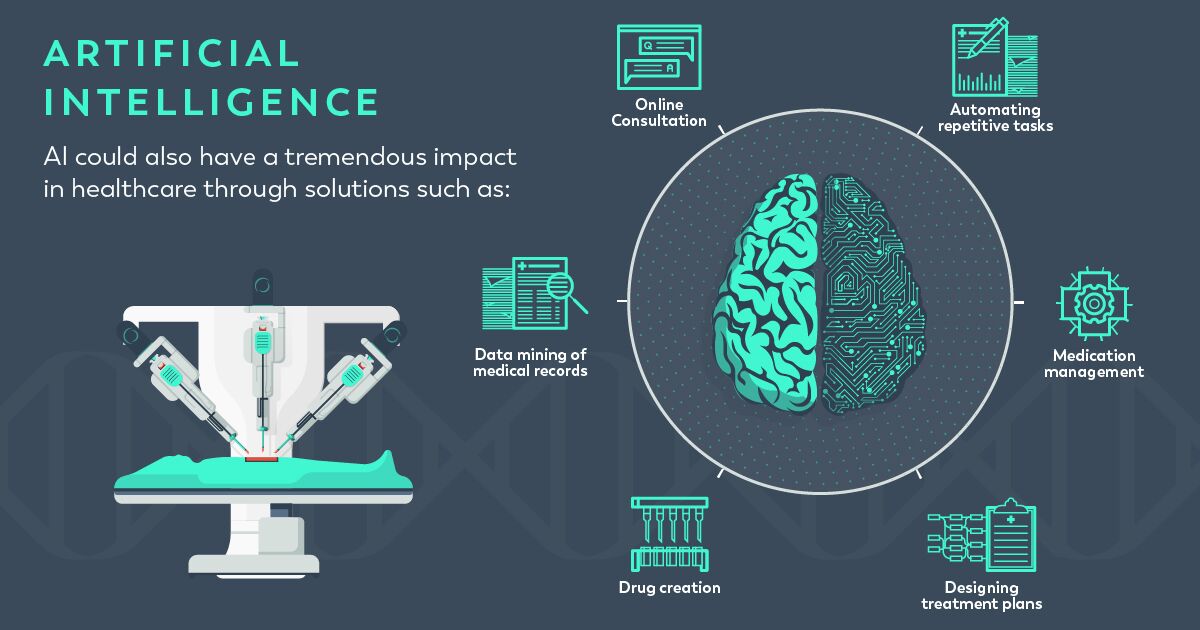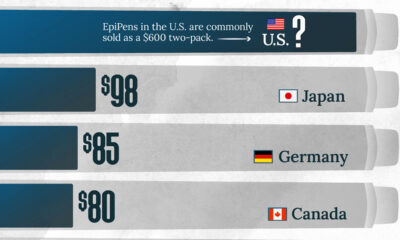Technology
Visualizing the Healthtech Revolution
Imagine being a patient in the early 19th century, when all ailments were considered “humors” to be ejected from the body. To restore balance, various techniques such as diets, natural herbs, or bloodletting with leeches were used – the only “technology” available at the time.
Even when the basic structure of modern medicine came into place, the average life expectancy was just 34 years old in 1913. A patient from that era would surely be amazed by the leaps and bounds that healthcare has undergone since then, thanks to the influence of technology.
The Healthtech Revolution
Today’s infographic dives into some of the technological advances that are pushing the boundaries of modern healthcare, and what this could mean for the sector.

What is Healthtech?
Healthcare technology, or healthtech, is the use of technology to better treat patients. Many such inventions have been credited for saving countless human lives since the 1800s.
Medicines, devices, procedures, and even organizational systems contribute to expanding life expectancy and improvements in quality of life.
From Fiction to Reality
Breakthroughs such as robotic arms, 3D bio-printed organs, and virtual reality for pain relief are being developed in the medical sector, drawing influences from the big screen.
Technologies that were once the staple of science fiction movies are rapidly becoming realities.
— Jeroen Tas, Chief Innovation Officer, Philips
But there’s a less tactile application of technology from science fiction that will arguably have an even bigger impact on healthcare: artificial intelligence (AI).
By recognizing patterns in behavior and creating their own logic, machine learning algorithms are set to transform various aspects of healthcare ranging from the automation of mundane tasks to the creation of entirely new drugs.
Healthcare at our Fingertips
Healthcare is also getting more mobile and connected, putting the Internet of Things (IoT) and mobile health (mHealth) at center stage as sources of potential disruption.
These technologies can help in everything from offering patients a convenient way to book appointments and pay bills online, to allowing doctors to use electronic health records to access and share information.
Wearable devices and smartphone apps are spiking in adoption as they unlock the option to monitor and manage individual health anytime, anywhere. This is creating an explosion in personal health data, which consumers are willing to share with their doctor if it will benefit them or others.
The Coming Healthtech Boom
Artificial intelligence, IoT, and mHealth are contributing to rapidly expanding healthtech sector, and each are expected to experience rapid growth by 2025:
| Healthcare segment | Current* | Projected (2025E) | CAGR |
|---|---|---|---|
| Artificial Intelligence | $2.1 billion | $36.1 billion | 50.2% |
| Global IoT | $120.2 billion | $543.3 billion | 20.2% |
| Global mHealth | $4.16 billion | $111.8 billion | 44.2% |
While healthtech won’t replace your doctor anytime soon, but it will certainly change your experience with healthcare – both on the front-end and behind the scenes.
Technology
All of the Grants Given by the U.S. CHIPS Act
Intel, TSMC, and more have received billions in subsidies from the U.S. CHIPS Act in 2024.

All of the Grants Given by the U.S. CHIPS Act
This was originally posted on our Voronoi app. Download the app for free on iOS or Android and discover incredible data-driven charts from a variety of trusted sources.
This visualization shows which companies are receiving grants from the U.S. CHIPS Act, as of April 25, 2024. The CHIPS Act is a federal statute signed into law by President Joe Biden that authorizes $280 billion in new funding to boost domestic research and manufacturing of semiconductors.
The grant amounts visualized in this graphic are intended to accelerate the production of semiconductor fabrication plants (fabs) across the United States.
Data and Company Highlights
The figures we used to create this graphic were collected from a variety of public news sources. The Semiconductor Industry Association (SIA) also maintains a tracker for CHIPS Act recipients, though at the time of writing it does not have the latest details for Micron.
| Company | Federal Grant Amount | Anticipated Investment From Company |
|---|---|---|
| 🇺🇸 Intel | $8,500,000,000 | $100,000,000,000 |
| 🇹🇼 TSMC | $6,600,000,000 | $65,000,000,000 |
| 🇰🇷 Samsung | $6,400,000,000 | $45,000,000,000 |
| 🇺🇸 Micron | $6,100,000,000 | $50,000,000,000 |
| 🇺🇸 GlobalFoundries | $1,500,000,000 | $12,000,000,000 |
| 🇺🇸 Microchip | $162,000,000 | N/A |
| 🇬🇧 BAE Systems | $35,000,000 | N/A |
BAE Systems was not included in the graphic due to size limitations
Intel’s Massive Plans
Intel is receiving the largest share of the pie, with $8.5 billion in grants (plus an additional $11 billion in government loans). This grant accounts for 22% of the CHIPS Act’s total subsidies for chip production.
From Intel’s side, the company is expected to invest $100 billion to construct new fabs in Arizona and Ohio, while modernizing and/or expanding existing fabs in Oregon and New Mexico. Intel could also claim another $25 billion in credits through the U.S. Treasury Department’s Investment Tax Credit.
TSMC Expands its U.S. Presence
TSMC, the world’s largest semiconductor foundry company, is receiving a hefty $6.6 billion to construct a new chip plant with three fabs in Arizona. The Taiwanese chipmaker is expected to invest $65 billion into the project.
The plant’s first fab will be up and running in the first half of 2025, leveraging 4 nm (nanometer) technology. According to TrendForce, the other fabs will produce chips on more advanced 3 nm and 2 nm processes.
The Latest Grant Goes to Micron
Micron, the only U.S.-based manufacturer of memory chips, is set to receive $6.1 billion in grants to support its plans of investing $50 billion through 2030. This investment will be used to construct new fabs in Idaho and New York.
-

 Science1 week ago
Science1 week agoVisualizing the Average Lifespans of Mammals
-

 Markets2 weeks ago
Markets2 weeks agoThe Top 10 States by Real GDP Growth in 2023
-

 Demographics2 weeks ago
Demographics2 weeks agoThe Smallest Gender Wage Gaps in OECD Countries
-

 United States2 weeks ago
United States2 weeks agoWhere U.S. Inflation Hit the Hardest in March 2024
-

 Green2 weeks ago
Green2 weeks agoTop Countries By Forest Growth Since 2001
-

 United States2 weeks ago
United States2 weeks agoRanked: The Largest U.S. Corporations by Number of Employees
-

 Maps2 weeks ago
Maps2 weeks agoThe Largest Earthquakes in the New York Area (1970-2024)
-

 Green2 weeks ago
Green2 weeks agoRanked: The Countries With the Most Air Pollution in 2023















